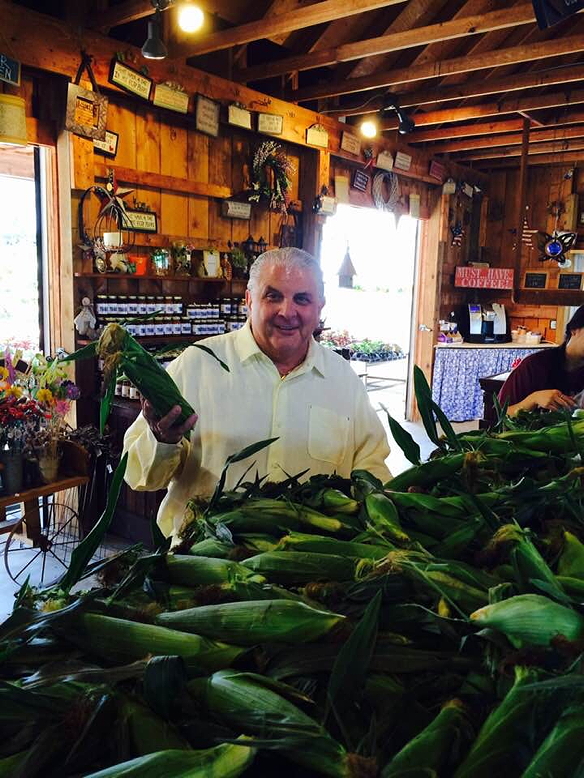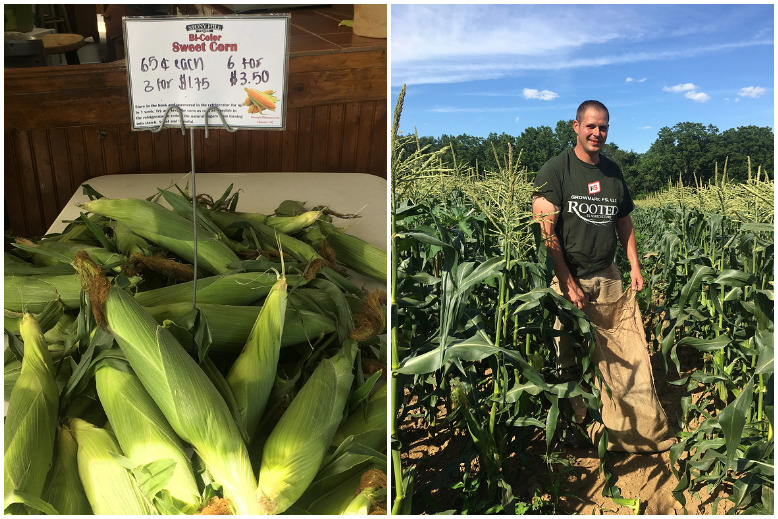
Produce Pete poses with corn at a New Jersey farm stand. Photo courtesy of Pete Napolitano
This is the first piece from “Produce Pete” Napolitano with Susan Bloom, a new monthly series we’re kicking off about fresh, local produce.
August is prime season for local corn in the Garden State and its delicious, sweet taste makes it worth every penny. But you’d be surprised at how many people complain to me about the cost of corn at their local farm stand. No matter where I am—at the supermarket, at a farmers’ market—someone will ask me how the price of fresh-picked corn can be as high as 75 cents per ear.
I try to explain to them that the key to great corn is time; the shorter the amount of time between when the corn was picked and when you eat it, the sweeter and better tasting it will be. The corn found in many supermarkets today is coming in from southeastern states, working its way up to New Jersey, and may be offered at around $2.99 or less for five ears, or at the “sale” price of 50 cents to 60 cents each. But by the time it gets to New Jersey supermarkets, especially if it’s not refrigerated or its temperature conditions vary while en route, it’s already several days old (and possibly up to seven days old if it’s being shipped from Florida during winter.) By then, the corn’s sugar is rapidly turning to starch, and this can negatively affect the taste. Fresh corn–often picked that morning and made available for sale immediately that day–ensures a premium product.
I also try to explain to people what goes into the harvesting of fresh corn. Back when I was a kid and our family owned Napolitano’s Produce in Bergenfield, my father would send my brother and me out to the farm to pick different fruits and vegetables for ourselves so that we’d understand what was involved in harvesting the products we sold. One day, when I was 13, I remember showing up to a local farm to pick corn wearing a t-shirt and shorts. The farmer, Wally Smith, looked me up and down, laughed, and asked me if I was going to the beach. He promptly gave me a pair of long pants and a jacket.
I couldn’t understand why I had to put them on in 100-degree weather, but I found out soon enough. If you don’t wear the right clothing, the leaves of the corn stalks will cut you to shreds. Corn stalks aren’t high-yielding plants; each stalk of the variety known as “eating corn” only yields two to four ears—and sometimes only one if they’re too small or don’t reach maturity, according to Dale Davis, farmer and head corn picker at the family-owned Stony Hill Farms in Chester. Pickers need to walk down many long, tight rows of corn stalks manually inspecting and snapping off each ear, putting them in a sack, and then bundling them in a truck or on a conveyor belt. It’s hot, sticky and hard manual labor with the sun beating down on you in the heat of the summer. Between sweating from the work itself and the presence of dew on the stalks if you’re picking first thing in the morning, you end up soaking wet after the day’s ears are collected. On top of that, the crop is subject to the ravages of weather conditions, deer, birds, insects and other hazards. Between that, labor, and transportation, there are a ton of variables involved.

From left, ears of fresh-picked corn available at Stony Hill Farms in Chester; and head corn picker Dale Davis harvests corn in one of their many fields. Photos courtesy of Susan Bloom
Given what’s involved in harvesting fresh corn, is 75 cents really too much for people to eat a fresh vegetable, partake in the bounty of the season, and support their local farmer? A can or frozen bag of vegetables can run $2 to $3 and they’ll pay that amount for those options, so why not buy the fresh version and benefit from its higher quality, taste and nutritional value? I joke that maybe the people who complain about the high price of fresh corn should go out into the field and pick corn themselves so that they’ll better understand what’s truly involved in getting that ear from the field to their plate.
The truth is, we still have the cheapest produce costs of any nation in the world; in fact, the cost to transport 75 to 80 percent of the produce in supermarkets is greater than the cost of the product itself. Sweet Jersey corn, which began coming into season in late June and will be available through mid-September (and potentially until late October and/or the first frost at sites like Stony Hill Farms) is only a three-month product, so get your fill now while it’s fresh, local, in season and bursting with flavor.
I hope that when people see fresh-picked farm corn priced at 60 cents to 80 cents an ear, they’ll remember what it took to get it there and will respect and value both the product and the process.
About “Produce Pete” Napolitano
With over 65 years of experience in the produce industry, New Jersey’s own “Produce Pete” Napolitano is a renowned fruit and vegetable expert, author, and television personality who’s appeared on a highly-popular segment on NBC’s Weekend Today in New York broadcast every Saturday mornings for over 27 years. For more information, visit Pete’s website.
About Susan Bloom
A contributor to New Jersey Monthly and a variety of other well-known local and national publications, Susan Bloom is an award-winning New Jersey-based freelance writer who covers topics ranging from health and lifestyle to business, food and more. She’s collaborated with Produce Pete on a broad range of articles for nearly a decade.
